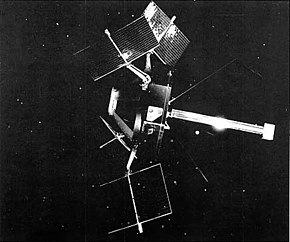Explorer 26
Explorer 26 was an American satellite launched on 21 December 1964, as part of NASA's Explorers Program. Its primary mission was to study the Earth's magnetic field.[1]
 Explorer 26 satellite | |
| Names | EPE-D S-3C Explorer XXVI |
|---|---|
| Mission type | Earth science |
| Operator | NASA |
| COSPAR ID | 1964-086A |
| SATCAT no. | 00963 |
| Spacecraft properties | |
| Launch mass | 45.8 kg (101 lb) [1] |
| Start of mission | |
| Launch date | 21 December 1964, 09:00:03 GMT |
| Rocket | Thor Delta C |
| Launch site | Cape Canaveral, Launch Complex 17A |
| Contractor | McDonnell Douglas |
| End of mission | |
| Last contact | 26 May 1967 |
| Orbital parameters | |
| Reference system | Geocentric orbit [2] |
| Regime | Low Earth orbit |
| Perigee altitude | 171 km (106 mi) |
| Apogee altitude | 8,545 km (5,310 mi) |
| Inclination | 18.10° |
| Period | 184.50 minutes |
Design
Explorer 26 was a spin-stabilized, solar-cell-powered spacecraft weighing 45.8 kg (101 lb). It carried five experiments: Solid-State Electron Detector, Omnidirectional and Unidirectional Electron and Proton Fluxes, Fluxgate Magnetometers, Proton-Electron Scintillation Detector, and Solar Cell Damage.[1] The Solar Cell Damage experiment was intended to quantify the degradation of solar cell performance due to radiation, and evaluate the effectiveness of glass shields at preventing this degradation.[3] A 16-channel PFM/PM time-division multiplexed telemeter was used. The time required to sample the 16 channels (one frame period) was 0.29 seconds. Half of the channels were used to convey eight-level digital information. The other channels were used for analog information. During ground processing, the analog information was digitized with an accuracy of 1/800th of full scale. One analog channel was subcommutated in a 16-frame-long pattern and used to telemeter spacecraft temperatures, power system voltages, currents, etc. A digital solar aspect sensor measured the spin period and phase, digitized to 0.036 seconds, and the angle between the spin axis and Sun direction to about 3° intervals.
Launch
Explorer 26 was launched from Cape Canaveral (CCAFS) at Launch Complex 17A (LC-17A) on a Thor Delta C launch vehicle on 21 December 1964 at 09:00:03 GMT.[4]
Mission
The spacecraft systems functioned well, except for some undervoltage turnoffs, until 26 May 1967, when the telemeter failed. The initial spin rate was 33 rpm, and the spin axis direction was right ascension 272.8° and declination 21.5°. The spin rate decreased with time to 2 rpm on 9 September 1965. For the balance of its life, the spacecraft was coning or tumbling at a rate of about 1 rpm.[1]
References
- "Display: Explorer 26 1964-086A". NASA. 14 May 2020. Retrieved 27 December 2020.
- "Trajectory: Explorer 26 1964-086A". NASA. 14 May 2020. Retrieved 27 December 2020.
- Luther W. Slifer; Stephen G. McCarron (1965). "Preliminary Results of the Explorer XXVI Solar Cell Experiment" (PDF). NASA Goddard Space Flight Center.
 This article incorporates text from this source, which is in the public domain.
This article incorporates text from this source, which is in the public domain. - "Launch Log". Jonathan's Space Report. Retrieved 9 June 2018.
.png.webp)
